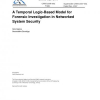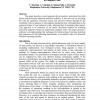MMMACNS
2005
Springer
15 years 6 months ago
2005
Springer
MMMACNS
2005
Springer
15 years 6 months ago
2005
Springer
Abstract. The recent proliferation of Internet worms has raised questions about defensive measures. To date most techniques proposed are passive, in-so-far as they attempt to block...
104
click to vote
MMMACNS
2005
Springer
15 years 6 months ago
2005
Springer
Making correct access-control decisions is central to security, which in turn requires accounting correctly for the identity, credentials, roles, authority, and privileges of users...
MMMACNS
2005
Springer
15 years 6 months ago
2005
Springer
The continuous general linear group in n dimensions can be decomposed into two Lie groups: (1) an n(n-1) dimensional ‘Markov type’ Lie group that is defined by preserving the ...
103
Voted
MMMACNS
2005
Springer
15 years 6 months ago
2005
Springer
The variety and richness of what users browse on the Internet has made the communications of web-browsing hosts an attractive target for surveillance. We show that passive external...
108
click to vote
MMMACNS
2005
Springer
15 years 6 months ago
2005
Springer
This paper describes a novel approach for preventative protection from both known and previously unknown malicious software. It does not rely on screening the code for signatures ...
110
click to vote
MMMACNS
2005
Springer
15 years 6 months ago
2005
Springer
Abstract. Amongst the challenges of ubiquitous computing is the need to provide management support for personal wireless devices and sensors. In this extended abstract we introduce...
82
Voted
MMMACNS
2005
Springer
15 years 6 months ago
2005
Springer
Abstract. This paper presents a method to generate unique and nevertheless highly random pseudonyms in a distributed environment. More precisely, each user can now generate his pse...
107
Voted
MMMACNS
2005
Springer
15 years 6 months ago
2005
Springer
A new model for representing temporal access control policies is introduced. In this model, temporal authorizations are represented by time attributes associated with both subjects...







